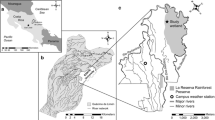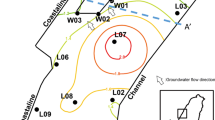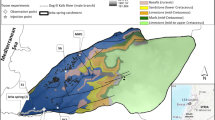Abstract
Understanding wetland hydrogeology is important as it is coupled to internal geochemical and biotic processes that ultimately determine the fate of potential contaminant inputs. Therefore, there is a need to quantitatively understand the complex hydrogeology of wetlands. The main objective of this study was to improve understanding of saturated groundwater flow in a forested riparian wetland located on a golf course in the Lower Pee Dee River Basin in South Carolina, USA. Field observations that characterize subsurface wetland flow critical to solute transport originating from storm-generated runoff are presented. Monitoring wells were installed, and slug tests were performed to measure permeabilities of the wetland soil. A field-scale bromide tracer experiment was conducted to mimic the periodic loading of nutrients caused by storm runoff. This experiment provided spatial and temporal data on solute transport that were analyzed to determine travel times in the wetland. Furthermore, a 3-D numerical, steady-state flow model (MODFLOW) was developed to simulate subsurface flow in the wetland. A particle tracking model was subsequently used to calculate solute travel times from the wetland inlet to the outlet based on flow modeling results. It was evident that observed tracer breakthrough times were not typical of these measured wetland soil matrix conductivity values. Based on surface water sampling results at the wetland outlet, tracer arrival time was about 9 h after the injection of the tracer. These results implied an apparent mean K value of 2,050 m/day, which is 152 times larger than the mean of the measured values using slug tests (13.4 m/day). Modeling efforts clearly demonstrated this implied preferential flow behavior; particle travel times resulting from the calibrated flow model were in the order of hundreds of days, while actual travel times in the wetland were in the order of hours to a few days. This significant difference in travel times was attributed to the presence of macropores in the form of dead root channels and cavities forming a pipe-flow network. The analyses presented in this study resulted in an estimate of the ratio of matrix permeability to matrix plus macropore permeability of approximately 1/150. Eventually, the tracer test and resulting travel times between various points in the wetland were critical to understanding the true wetland flow dynamics. The final conceptual model of the hydraulic properties of the wetland soils comprised a low permeability matrix containing a web of high K macropores. Simulation of tracer transport in this system was possible using a flow model with significantly elevated K values.








Similar content being viewed by others
References
Aucott, W. R. (1996). Hydrology of the Southeastern Coastal Plain aquifer system in South Carolina and parts of Georgia and North Carolina. U.S. Geological Survey Professional Paper 1410-E.
Bouwer, H., & Rice, R. C. (1976). A slug test for determining hydraulic conductivity of unconfined aquifers with completely or partially penetrating wells. Water Resources Research, 12, 423–428.
Buttle, J. M., & Leigh, D. G. (1997). The influence of artificial macropores on water and solute transport in laboratory soil columns. Journal of Hydrology, 191, 290–314.
Casey, R. E., & Klaine, S. J. (2001). Nutrient attenuation by a riparian wetland during natural and artificial runoff events. Journal of Environmental Quality, 30, 1720–1731.
Casey, R. E., Taylor, M. D., & Klaine, S. J. (2001). Mechanisms of nutrient attenuation in a subsurface flow riparian wetland. Journal of Environmental Quality, 30, 1732–1737.
Casey, R. E., Taylor, M. D., & Klaine, S. J. (2004). Localization of denitrification activity in macropores of a riparian wetland. Soil Biology & Biochemistry, 36, 563–569.
Cey, E. E., Rudolph, D. L., Aravena, R., & Parkin, G. (1999). Role of the riparian zone in controlling the distribution and fate of agricultural nitrogen near a small stream in southern Ontario. Journal of Contaminant Hydrology, 37, 45–67.
Devito, K. J., Waddington, J. M., & Branfireun, B. A. (1997). Flow reversals in peatlands influenced by local groundwater systems. Hydrological Processes, 11, 103–110.
Elci, A. (2003). Experimental and theoretical study of subsurface flow and transport in a riparian wetland. Ph.D. Dissertation, Clemson University, Clemson, SC, USA, p. 167.
Eser, P., & Rosen, M. R. (1999). The influence of groundwater hydrology and stratigraphy on the hydrochemistry of stump bay, south Taupo wetland, New Zealand. Journal of Hydrology, 220, 27–47.
Feehley, C. E., Zheng, C., & Molz, F. J. (2000). A dual-domain mass transfer approach for modeling solute transport in heterogeneous aquifers: application to the macrodispersion experiment (made) site. Water Resources Research, 36(9), 2501–2515.
Fetter, C. W. (2001). Applied hydrogeology. Upper Saddle River, NJ: Prentice Hall.
Flach, G. P., Crisman, S. A., & Molz, F. J. (2004). Comparison of single-domain and dual-domain subsurface transport models. Ground Water, 42(6–7), 815–828.
Flury, M., & Papritz, A. (1993). Bromide in the natural-environment—occurrence and toxicity. Journal of Environmental Quality, 22(4), 747–758.
Fraser, C. J. D., Roulet, N. T., & Lafleur, M. (2001). Groundwater flow patterns in a large peatland. Journal of Hydrology, 246, 142–154.
Groffman, P. M., Howard, G., Gold, A. J., & Nelson, W. M. (1996). Microbial nitrate processing in shallow groundwater in a riparian forest. Journal of Environmental Quality, 25, 1309–1316.
Harbaugh, A. W., & McDonald, M. G. (1996). User’s documentation for MODLFOW-96, an update to the USGS modular finite-difference ground-water flow model.
Harvey, J. W., Chambers, R. M., & Hoelscher, J. R. (1995). Preferential flow and segregation of porewater solutes in wetland sediments. Estuaries, 18(4), 568–578.
Hill, A. R. (1996). Nitrate removal in stream riparian zones. Journal of Environmental Quality, 25, 743–755.
Hoag, R. S., & Price, J. S. (1995). A field-scale, natural gradient solute transport experiment in peat at a Newfoundland blanket bog. Journal of Hydrology, 172, 171–184.
Hoffmann, C. C., Berg, P., Dahl, M., Larsen, S. E., Andersen, H. E., & Andersen, B. (2006). Groundwater flow and transport of nutrients through a riparian meadow—field data and modelling. Journal of Hydrology, 331(1–2), 315–335.
Hyder, Z., Butler, J. J., McElwee, C. D., & Liu, W. Z. (1994). Slug tests in partially penetrating wells. Water Resources Research, 30(11), 2945–2957.
Iqbal, M. Z. (1999). Role of macropores in solute transport under ponded water condition produced by laboratory simulated intense storms. Ground Water, 37(5), 674–681.
Kadlec, R. H. (1994). Detention and mixing in free water wetlands. Ecological Engineering, 3, 345–380.
Kelly, B. P., & Pomes, M. L. (1998). Potential flow and transport of nitrate and bromide in claypan soil. Ground Water, 36(3), 484–494.
Li, Y., & Ghodrati, M. (1997). Preferential transport of solute through soil columns containing constructed macropores. Soil Science Society of America Journal, 61, 1308–1317.
Maitre, V., Cosandey, A. C., Desagher, E., & Parriaux, A. (2003). Effectiveness of groundwater nitrate removal in a river riparian area: the importance of hydrogeological conditions. Journal of Hydrology, 278, 76–93.
McWhorter, D. B., & Sunada, D. K. (1977). Ground-water hydrology and hydraulics. Fort Collins, CO: Water Resources.
Mitsch, W. J., & Gosselink, J. G. (2000). Wetlands. New York: Wiley.
Molz, F. J., Guan, J., & Wang, J. (2005). Spatial weighting functions: transient hydraulic tests and heterogeneous media. Ground Water, 43, 215–221.
Murphy, K.-L. (1999). The geohydrologic characterization of a wetland in Cheraw, SC. M.Sc. Thesis, Clemson University, Clemson, SC, USA, p. 143.
Nwankwor, G. I., & Anyaogou, C. N. (2000). Hydrologic characteristics of a small tropical riverine wetland at Ulakwo, Imo State, Nigeria. Hydrogeology Journal, 8, 646–653.
Parsons, D. F., Hayashi, M., & Van Der Kamp, G. (2004). Infiltration and solute transport under a seasonal wetland: bromide tracer experiments in Saskatoon, Canada. Hydrological Processes, 18(11), 2011–2027.
Peterjohn, W. T., & Correll, D. L. (1984). Nutrient dynamics in an agricultural watershed observations on the role of a riparian forest. Ecology, 65(5), 1466–1475.
Pollock, D. W. (1994). User’s guide for MODPATH/MODPATH-PLOT, version 3: a particle tracking post-processing package for MODLFOW, the USGS finite-difference ground-water flow model. U.S. Geological Survey Open-File Report; 94-464. U.S. Geological Survey, Reston, VA, p. 464.
Prudic, D. E. (1989). Documentation of a computer program to simulate stream-aquifer relations using a modular, finite-difference, ground-water flow model. U.S. Geological Survey Open-File Report 88-729.
Puckett, L. J. (2004). Hydrogeologic controls on the transport and fate of nitrate in ground water beneath riparian buffer zones: results from thirteen studies across the united states. Water Science and Technology, 49(3), 47–53.
Reeve, A. D., Siegel, D. I., & Glaser, P. H. (2000). Simulating vertical flow in large peatlands. Journal of Hydrology, 227(1–4), 207–214.
Rutherford, J. C., & Nguyen, M. L. (2004). Nitrate removal in riparian wetlands: interactions between surface flow and soils. Journal of Environmental Quality, 33, 1133–1143.
Sabater, S., Butturini, A., Clement, J. C., Burt, T., Dowrick, D., Hefting, M., et al. (2003). Nitrogen removal by riparian buffers along a European climatic gradient: patterns and factors of variation. Ecosystems, 6, 20–30.
Thomasson, M. J., & Wierenga, P. J. (2003). Spatial variability of the effective retardation factor in an unsaturated field soil. Journal of Hydrology, 272(1–4), 213–225.
Waddington, J. M., Roulet, N. T., & Hill, A. R. (1993). Runoff mechanisms in a forested groundwater discharge wetland. Journal of Hydrology, 147, 37–60.
Zeeb, P. J., & Hemond, H. F. (1998). Simulation of transient responses of a wetland/stream flow regime to evapotranspiration, recharge, and surface flooding. In MODFLOW ’98. pp. 895–903.
Acknowledgements
This study was supported in part by the South Carolina Turf-Grass Association, the U.S. Department of Energy and Clemson University.
Author information
Authors and Affiliations
Corresponding author
Rights and permissions
About this article
Cite this article
Elçi, A., Molz, F.J. Identification of Lateral Macropore Flow in a Forested Riparian Wetland through Numerical Simulation of a Subsurface Tracer Experiment. Water Air Soil Pollut 197, 149–164 (2009). https://doi.org/10.1007/s11270-008-9798-5
Received:
Accepted:
Published:
Issue Date:
DOI: https://doi.org/10.1007/s11270-008-9798-5




